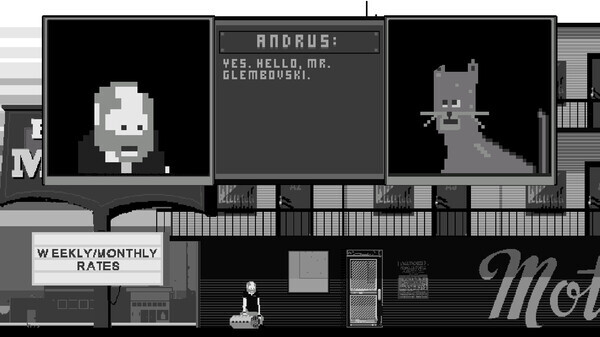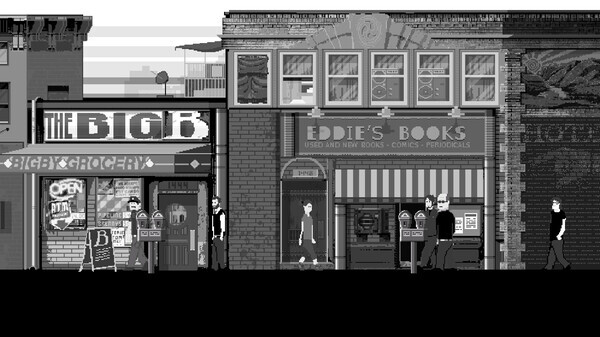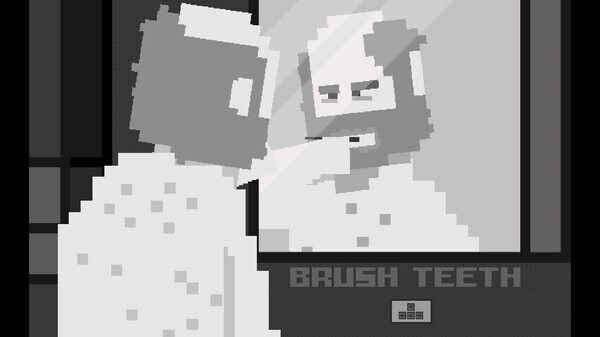After being taken off Steam nearly a decade ago, the once-indie-darling Cart Life is readying up for its resurrection.
When it comes to identifying the single-most important year for indie games–the one that helped showcase their innovation and saw their influence grow–it doesn’t take much to make a case for 2013. It was the year of The Stanley Parable and Papers, Please, of Hotline Miami and Don’t Starve. Gone Home and Kentucky Route Zero were another two that were particularly notable, and lest we forget Rogue Legacy, Guacamelee, Surgeon Simulator, Antichamber, and Depression Quest. It was a year that was not solely defined by a new Grand Theft Auto, but in part by a growth in intimate and innovative titles. This of course makes it all the more interesting that one of the most critically-acclaimed games of that year–the one that took home the Seumas McNally Grand Prize at the annual Independent Games Festival–is one that all but disappeared.
Richard Hofmeier’s Cart Life is a simulation-adventure game that follows three cart vendors simply trying to make rent and get by. Back in 2013, it was praised for how its immersive mechanics forced players to experience similar frustrations to the vendors they play as, and for being an empathic ode to the working class. Yet for much of the last decade, it has been largely unplayable. Between delistings, bugs, and certain portions of the game being locked behind said bugs, the solo venture has teetered on the edge of remembrance. This is exactly why AdHoc Studio decided to contact Hofmeier and change that.
Earlier this year, GameSpot got the chance to sit down with AdHoc Studio co-founder Nick Herman, talk to him about the process of finishing and publishing Cart Life, and play the first 20 minutes. While the game was still far from finished, the experience of playing Cart Life and seeing firsthand what made it special all those years ago was exciting. Despite nearly a decade passing, the mechanics still feel impactful and unique, and the story remains poignant. However, even more enlightening was the conversation I had with Herman about the game, which is slated for release later this year.

So I’d love to hear more about Cart Life’s history. It’s a unique situation.
Nick Herman: Yeah. The game won big at the Independent Games Festival, but Richard, who was a solo dev, who had never done this before, and who didn’t really know that making video games was a thing that people could do by themselves, was really just doing it more as a medium to express himself. So when he did put it out on Steam, the game was buggy and it wasn’t actually complete–he was just trying to share it with folks. But then a lot of people showed up and were like, “Hey man, you got to fix your game.” And he had already been working on it for four years, and was really overwhelmed and kind of overworking on it. So he just put it back out there for free. He took it off Steam and released all the source code for folks to figure it out themselves, if they wanted to.
No one did. No one took him up on that. I mean, I’m sure people poked around, but no one really went through the process of fixing his game and doing anything with it. There were actually one or two folks who tried, but I don’t think there was ever a full, complete game.
But this game, back in 2013, got a bunch of the AdHoc folks talking. While we were working for Telltale, specifically on The Walking Dead, we saw the game, we played the game, and we loved it. It remained this thing that we found ourselves talking about repeatedly over the last 10 years.
It is still relevant to us and is such a special experience that we haven’t seen anyone recreate, at least not in the same ways Richard did when he approached the design of the game, because they’re not very not mainstream decisions he made. The game is intentionally obtuse and difficult at times. And it’s not because he doesn’t know what he’s doing. It’s because that’s the type of experience he’s trying to facilitate.
It definitely seems like it was a bit ahead of the curve.
Herman: In some ways, I think it was, yeah. And what’s interesting now is that playing it and working on it 10 years later, it still feels super relevant [thanks to] a lot of the themes that it deals with, but also it still feels fresh. It doesn’t feel like something that you have really seen since. That’s what really made us want to make sure this game was able to be shared with other people. And the fact that you couldn’t download it or buy it anywhere was a bummer.
So, we reached out [to creator Richard Hofmeier] and we talked. Turns out, he had spent the last 10 years working a bunch of random jobs. He was a firefighter, he was a dessert chef… He really wanted to make sure that he understood what the average person’s life was like. He didn’t want to end up sitting in front of a computer for his whole life and making games and lose touch with reality a little bit. And Cart Life is so specifically about individuals struggling just to make ends meet. And I think he felt sort of a duty, if he was going to continue to be an artist, to know what that meant, or just meet people and explore more of life than just being in game dev.
It’s part of what makes Richard such a special creator and this game is… It kind of became his life, and I think he was afraid of that overwhelming him.
What were some of the things that players noted as “broken” or needing to be fixed? What does that itemized list of things you want to fix up look like?
Herman: There were a bunch of really brutal bugs. Things like if you play a certain way, or when you’re in the cash register and you’re sorting through your cash, if you hit a certain piece of the UI, it just totally screws the game up. He was also working in Adventure Game Studio, which is not a modern engine. It has its own sort of problems. For example, if you update the game and you release a patch, it deletes everyone’s saves. That’s just built into the engine. So anytime he even had a fix, he was reluctant to push it because he knew it was going to screw up so many playthroughs. Oh, and one of the characters also had a bug that made it so you couldn’t even complete his story. There was so much content that people never got to see.
So we’re going to fix all that stuff and update it, but also one of the goals is to get it on console. We’re having to change a lot of the game mechanics since before it was very keyboard-centric. There’s typing minigames and a bunch of stuff that is only doable on a keyboard.
A lot of the mechanics have changed from a gameplay standpoint; there’s new content, and there’s new art. There’s going to potentially be an epilogue, too. There’s so much that we weren’t really sure what to call it. We weren’t sure if it was a remaster, a sequel, a definitive edition, or a director’s cut. We ended up just calling it Cart Life because we felt like the game never really got a full, proper launch 10 years ago, and this is really the game that Richard wanted to release. It feels like this is the actual release. I think if early access existed back in the day, we would’ve looked at it like that.

I’d also love to know more about your studio, AdHoc. Is the whole team former members of Telltale? What’s that story? And why Cart Life?
Herman: So the founders met at Telltale, we were all there for varying lengths, and then eventually some of us went to Ubisoft for a couple years and Michael [Michael Choung, co-founder of AdHoc Studio] went to work at Night School Studios, which did Oxenfree. So we kind of went in different ends of the spectrum, AAA and indie. And then a couple years later, we came back together and started Ad Hoc. This is prior to Telltale shutting down, and we just wanted to get back to doing what we loved, which was telling great interactive stories. It was definitely not our intention to become a publisher. It’s not why we started the studio, but this just felt right.
[Cart Life] is a game that we cared about. It’s a game that cares about the things that we want to see in games, and we want to continue to be advocates for. It felt like we had an opportunity to do something for someone that we would hope someone would do for us if we were in that position, and be able to provide support. Really we’re trying to stay out of Richard’s way as much as possible and just give him what he needs. And I think he likes to say that we’re involved in development, but […] I don’t want to put any of my own influences on this game because this game is Richard. I don’t want to infect it, because I feel like it’s great the way it is. And so, yeah, this just made sense for us. We’re not sort of out to be an indie publisher or anything like that, but I think in the future, if something else made sense, we would do it. But this is really just about Cart Life.
I feel like when you talk to other game developers, a lot of them have played this game and remember it as a very special experience. But when you talk to people who just play games, it doesn’t even register. They’ve never heard of it. When we talk about 2013, [we talk about] Hotline Miami, Gone Home, Kentucky Route Zero… Yet all these games lost to this game at IGF. This game beat them in three categories. So it’s like, how the hell did everyone miss this? It feels wrong. And we love and play all those games too. This is not at all to say that they’re lesser than Cart Life.
So with 10 years passing, are there things that are being altered story-wise within the game to reflect modern politics or create new social commentary?
Herman: Richard decided to still have it take place in 2013, so it’s most relevant to when the game was made, but he has been talking about, once you complete all three characters stories, [having] one of the characters come back in 2023 so you can see how this town has changed based on your decisions and based on the time that’s passed. So I think there may be some things there, but we tried to keep the game preserved in the time and place that it was created. Richard made [Cart Life] with a really specific setting in mind and wants that to be reflected.
So playing this now, it seems you really kept the integrity of the original art and design–the feel of it and the music.
Herman: Yeah. I mean, we did have to completely rebuild the whole game. So it may look the same to a lot of folks, but it’s completely redone from scratch. Well, not from scratch–using all the art, original art–but we had to port it into Unity which is a whole thing.

Do all three of the characters’ stories end up kind of intertwining with one another?
Herman: Yeah, so you can play any of the three characters from the jump, and the order in which you play them affects the other characters’ lives. It’s essentially three weeks, one week per character. The decisions you make as your first character will carry forward into what the next character that you play as.
Is it the sort of thing where you have very different experiences than each time you replay it? Or is it more, there’s a “right way” to play it and you have to figure it out?
Herman: I think that’s a little bit subjective. I think there probably is the best ending for all these characters, but… Well, one of the things that, with my experience with this game 10 years ago, was that I was pretty frustrated at first. I was like, “Why isn’t the game telling me how to do this? Why do I feel like I’m lost, or I feel like I don’t understand how to get this thing that I want?” And the game forces you to stumble through it a bit, just like the character you’re playing. Andris [the first playable character in Cart Life] is a Ukrainian immigrant, which 10 years ago was maybe a little less relevant than it is today, but he doesn’t know anything about this city. He is kind of fumbling his way through it. And I think by forcing the player to go through that experience with him, it’s ultimately much more satisfying when you do start to figure it out and do start to get good at the pieces of the game.
Things can go poorly for all these characters. And there’s multiple end states for everyone. For instance, Melanie, her story is all about trying to keep custody of her child during a divorce hearing, and she needs to prove that she can make money and pay rent. And so she can deal with that in a bunch of different ways. But there’s a lot going on in her life, a lot of plates spinning in the air that you have to keep up, and it’s not always possible to keep them all spinning. That’s an example of a character where if you want, you can, on the first day, go book a train and just abandon your family. That’s possible. I wouldn’t recommend it, but the game allows you to express yourself in that way.
I think it’s just more about the experience of playing and dealing with the consequences of [situations like] forgetting that you’re supposed to go pick up your daughter at school at 4 PM. It’s just shit like that. There’s no restart in life. There’s no pause button. So in Cart Life, you can’t pause the game because Richard doesn’t want that to be this artifice between you and feeling the pressure of life. A lot of the design decisions, I think, are what make this game special.
The products discussed here were independently chosen by our editors. GameSpot may get a share of the revenue if you buy anything featured on our site.
Got a news tip or want to contact us directly? Email news@gamespot.com

Cart Life
We’ll begin emailing you updates about %gameName%.







